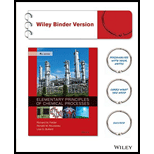
Sodium bicarbonate is synthesized by reacting sodium carbonate with carbon dioxide and water at 70°C and 2.0 atm gauge pressure:
An aqueous solution containing 7.00 wt% sodium carbonate and a gas stream containing 70.0 mole% CO2and the balance air are fed to the reactor. All of the sodium carbonate and some of the carbon dioxide in the feed react. The gas leaving the reactor, which contains the air and unreacted CO2, is saturated with water vapor at the reactor conditions. A liquid—solid slurry of sodium bicarbonate crystals in a saturated aqueous solution containing 2.4 wt% dissolved sodium bicarbonate and a negligible amount of dissolved CO2leaves the reactor and is pumped to a ?lter. The wet ?lter cake contains 86 wt% sodium bicarbonate crystals and the balance saturated solution, and the ?ltrate also is saturated solution. The production rate of solid crystals is 500 kg/h.
Suggestion: Although the problems to be given can be solved in terms of the product ?ow rate of 500 kg NaHCO3(s)/h, it might be easier to assume a different basis and then scale the process to the desired production rate of crystals.
(a) Calculate the composition (component mole fractions) and volumetric ?ow rate (m3/min) of the gas stream leaving the reactor.
(b) Calculate the feed rate of gas to the process in standard cubic meters/min [m3(STP)/min].
(c) Calculate the ?ow rate (kg/h) of the liquid feed to the process. What more would you need to know to calculate the volumetric ?ow rate of this stream?
(d) The ?ltrate was assumed to leave the ?lter as a saturated solution at 70°C. What would be the effect on your calculations if the temperature of the ?ltrate actually dropped to 50°C as it passed through the ?lter?
(e) The reactor pressure of 2 atm gauge was arrived at in an optimization study. What bene?t do you suppose would result from increasing the pressure? What penalty would be associated with this increase? The term “Henry's law" should appear in your explanation. (Hint: The reaction occurs in the liquid phase and the CO2enters the reactor as a gas. What step must precede the reaction?)
Learn your wayIncludes step-by-step video

Chapter 6 Solutions
Elementary Principles of Chemical Processes, Binder Ready Version
Additional Engineering Textbook Solutions
Process Dynamics and Control, 4e
Elements of Chemical Reaction Engineering (5th Edition) (Prentice Hall International Series in the Physical and Chemical Engineering Sciences)
Fundamentals Of Thermodynamics
Problem Solving with C++ (9th Edition)
DeGarmo's Materials and Processes in Manufacturing
Management Information Systems: Managing the Digital Firm (15th Edition)
 Introduction to Chemical Engineering Thermodynami...Chemical EngineeringISBN:9781259696527Author:J.M. Smith Termodinamica en ingenieria quimica, Hendrick C Van Ness, Michael Abbott, Mark SwihartPublisher:McGraw-Hill Education
Introduction to Chemical Engineering Thermodynami...Chemical EngineeringISBN:9781259696527Author:J.M. Smith Termodinamica en ingenieria quimica, Hendrick C Van Ness, Michael Abbott, Mark SwihartPublisher:McGraw-Hill Education Elementary Principles of Chemical Processes, Bind...Chemical EngineeringISBN:9781118431221Author:Richard M. Felder, Ronald W. Rousseau, Lisa G. BullardPublisher:WILEY
Elementary Principles of Chemical Processes, Bind...Chemical EngineeringISBN:9781118431221Author:Richard M. Felder, Ronald W. Rousseau, Lisa G. BullardPublisher:WILEY Elements of Chemical Reaction Engineering (5th Ed...Chemical EngineeringISBN:9780133887518Author:H. Scott FoglerPublisher:Prentice Hall
Elements of Chemical Reaction Engineering (5th Ed...Chemical EngineeringISBN:9780133887518Author:H. Scott FoglerPublisher:Prentice Hall
 Industrial Plastics: Theory and ApplicationsChemical EngineeringISBN:9781285061238Author:Lokensgard, ErikPublisher:Delmar Cengage Learning
Industrial Plastics: Theory and ApplicationsChemical EngineeringISBN:9781285061238Author:Lokensgard, ErikPublisher:Delmar Cengage Learning Unit Operations of Chemical EngineeringChemical EngineeringISBN:9780072848236Author:Warren McCabe, Julian C. Smith, Peter HarriottPublisher:McGraw-Hill Companies, The
Unit Operations of Chemical EngineeringChemical EngineeringISBN:9780072848236Author:Warren McCabe, Julian C. Smith, Peter HarriottPublisher:McGraw-Hill Companies, The





